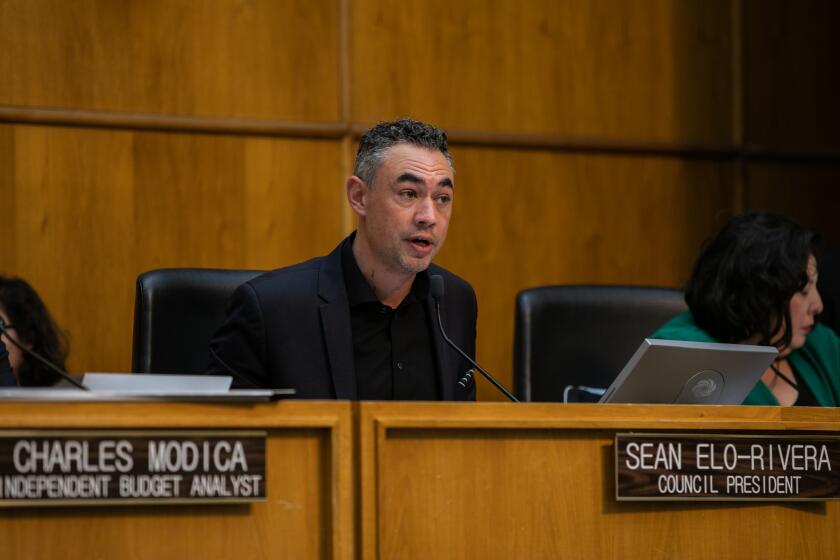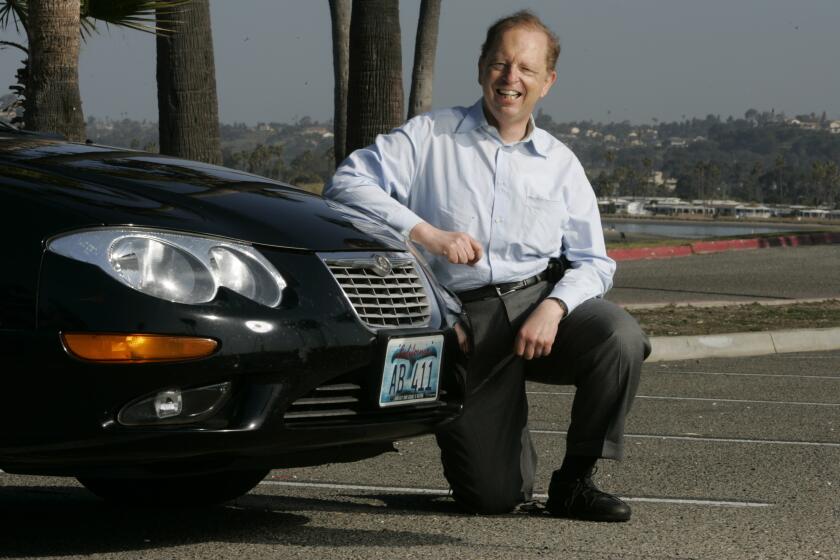San Diego proposal to wipe out parking requirements takes key step forward
A proposal to help solve San Diego’s housing crisis by wiping out parking requirements for new condominium and apartment complexes in neighborhoods near mass transit took a key step forward on Wednesday.
The City Council’s Land Use and Housing Committee voted 3-1 in favor of the proposal, and forwarded it to the full nine-member council for final approval on March 4.
Council members in favor of the plan said it’s a key step toward reducing local reliance on automobiles, making housing cheaper and helping the city meet the goals of its legally binding climate action plan.
They called the existing parking requirements outdated and too steep, while praising the proposal for giving housing developers needed flexibility as more young people choose to commute by transit, bicycle and ride-booking services.
“This is a very good, well-thought-out proposal,” Councilman Scott Sherman said. “The cost of parking is incredibly detrimental to the cost of housing. This provides a lot of flexibility for us to let people deal with the market as it is today and what it could be in the future.”
Councilman Chris Ward noted that many other large cities have made similar policy changes based on emerging trends, including San Francisco, Oakland, Sacramento, Santa Monica, Portland, Seattle and Minneapolis.
“We’re certainly not first out of the gate in the country to be able to look at this opportunity,” he said.
Councilwoman Dr. Jennifer Campbell, who cast the lone “no” vote, said wiping out parking requirements would be premature despite its potential to help solve the housing crisis and reduce production of greenhouse gases.
“I think this is an idea whose time has not come,” said Campbell, noting that nearly 94 percent of San Diego adults own a car. “The removal of parking requirements seems to me to be one of the last steps we should take to get away from car-centric transit, instead of one of the first steps.”
Campbell, whose district includes the city’s beach communities, said the neighborhoods she represents are already experiencing a parking crisis even without the proposed reduction in requirements.
“In my district, there are no parking spaces left on streets in the evenings or on weekends,” Campbell said. “Putting in zero parking, while adding residential density without infrastructure for mass transit being already present, will lead to chaos in neighborhoods.”
The city’s planning staff told the committee they are confident the impact of the new policy would be gradual and only affect neighborhoods where demand for housing without parking spots already exists.
“Trends are showing an increase in those young professionals that are looking to reduce car reliance,” said Alyssa Muto, a deputy director in the city’s Planning Department. “They’re looking to live in neighborhoods where all neighborhood services, their jobs and their living can happen within a walk, bike or transit commute.”
Developers wouldn’t risk millions of dollars building projects without parking spots unless market studies show there is adequate demand in a particular neighborhood for housing without parking, she said.
Parking spots typically increase the cost of an individual housing unit anywhere from $35,000 to $90,000, so relaxing parking requirements would spur more housing construction.
The proposal wouldn’t retroactively wipe out parking requirements for existing housing projects; it would only apply to new construction.
The only neighborhoods eligible for the new policy are those near transit hubs, which is defined as being located within half a mile of a trolley line, a bus rapid transit station or two high-frequency bus routes. The transit must either be already operating or scheduled to begin operating within five years.
The proposal, which was unveiled last month by Mayor Kevin Faulconer during his annual State of the City speech, has faced significant pushback.
A group of neighborhood leaders from across San Diego last month called it unrealistic and too aggressive for a city that lacks quality transit and was built for automobiles.
The group of leaders, the Community Planners Commission, recommended the city soften the proposal by making it a short-term “pilot project” and by exempting all beach communities because of parking scarcity there.
The San Diego Planning Commission, however, unanimously supported the proposal last week.
They said that while the plan is bold and aggressive, it is a necessary step toward solving the city’s housing crisis, reducing pollution and alleviating traffic congestion.
The commission did express some concerns about how the policy change would impact low-income neighborhoods that lack supermarkets, banks or pharmacies, because those voids make it difficult to survive without a car.
On Wednesday, the Downtown San Diego Partnership and a downtown developer criticized part of the proposal that would set a maximum of one parking spot per unit of housing constructed downtown.
While they expressed support for making downtown a transit-focused area where fewer residents rely on cars, they said it would be a mistake to limit the flexibility of developers who believe units won’t sell with only one parking spot.
Mike Hansen, the city’s planning director, said such complaints have prompted city staff to reconsider that requirement. He said they are already exploring revisions to the downtown parking maximum and expect to present them to the full council on March 4.
The overall proposal has been praised by environmental groups, merchant associations and mobility advocacy groups.
“The chamber believes reducing parking requirements would take us one step closer to our shared goals of increasing our housing stock and complying with the climate action plan,” said Stefanie Benvenuto, a policy analyst for the San Diego Regional Chamber of Commerce.
Maya Rosas, policy director for Circulate San Diego, said critics have exaggerated the immediate impact of the policy change.
“These changes aren’t going to happen overnight,” she said.
Molly Kirkland of the San Diego Apartment Association stressed that the policy change doesn’t require developers not to include parking with new housing projects, it just gives them flexibility if that’s what the market demands.
“Developers respond to demand and they will address that in their projects,” she said.
The proposal can be seen at sandiego.gov/planning/programs/transportation/mobility/tpa.
david.garrick@sduniontribune.com (619) 269-8906 Twitter:@UTDavidGarrick
Get Essential San Diego, weekday mornings
Get top headlines from the Union-Tribune in your inbox weekday mornings, including top news, local, sports, business, entertainment and opinion.
You may occasionally receive promotional content from the San Diego Union-Tribune.












